#it’s about sorawo as an egg
Text





woah they weren’t lying that picnic is on the otherside
#otherside picnic#soratori#sorawo kamikoshi#the last one is actually from a series of 4koma ive dubbed egg sorawo#it’s about sorawo as an egg#i have like 4(?) others mocked up with help from my beautiful girlfriend#so if anyone’s interested lmk 🫡#my art#egg sorawo
1K notes
·
View notes
Text
A fun element to Otherside Picnic vol 8 (spoilers ahead after the break, if you're still planning to read it) is an easter egg about the location of Toriko's apartment. Actually, "easter egg" might be underselling it a bit; it has a huge amount of thematic relevance to Toriko's character. So here's the easter egg: if you follow Sorawo's description of her path to Toriko's apartment, you can actually find the building on Google Maps.
The train arrived in Nippori. Pushed by the rush of people, I got off, went down the stairs, and out the gate.
I climbed the hill, out of breath, in the unrelenting rain. The wall of a graveyard continued along the left-hand side. Turning onto a side street at the top of the hill, I could see Toriko’s apartment in the middle of a residential area
...the building uses an autolock system...
Getting off on the fourth floor, I headed into the hallway. The town I could see over the chest-high wall was misty in the rain.
The fun thing about this is that Sorawo's narration is just specific enough to follow along. In a way, it's an invitation to the reader to imitate Sorawo. Prior to the events of the series, she spent time tracking down the sites of ghost stories from the minor details that leaked into their narration. Tracking down where the weirdness happened placed it in context; stories from the edge of reality seem more reliable when the reality can be charted.
So, let's do it. Sorawo mentions a graveyard wall - this can only be Yanaka Graveyard, located on the west side of Nippori Station. Yanaka is located on the former grounds of the Tenno-ji Buddhist temple, and is one of Tokyo's largest cemetaries by area. It is the resting site of the final Tokugawa Shogun, as well as a who's who of Meiji-era academics, literati, and government officials.
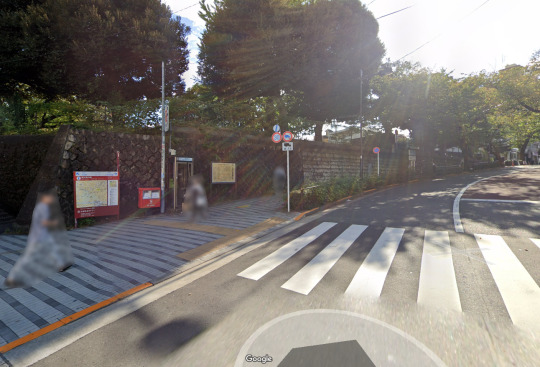
The road along the north edge of Yanaka Graveyard goes up a steep hill, and where it reaches the top, a side road splits off on the left to go into a residential area. Going into street view shows that all of the buildings along this road are only two or three stories tall, except for a building at the very back. It's four stories tall. The building has an auto lock system at the front door, and chest high walls along the hallways to the apartments. Bingo.
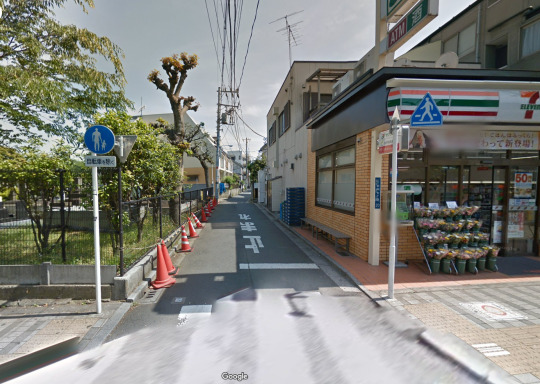

The fun part of this is the name of the apartment complex: 山口マンシ��ン (Yamaguchi [Mountain Gate] Mansion).
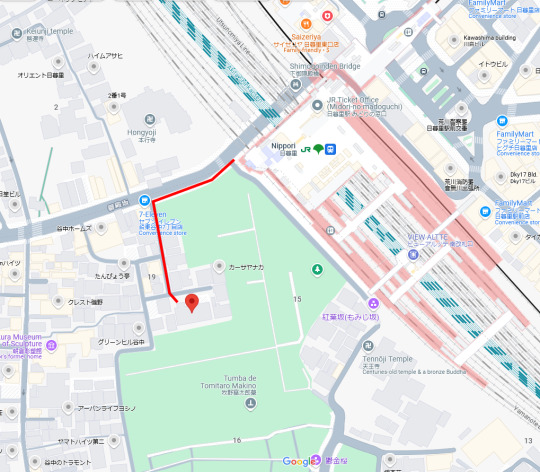
The first part of the thematic relevance here is its relationship to Satsuki's monologue about being brought into the Otherside.
"What happens to the people who don't return?"
"Who knows? They probably die, right?"
"Life and death aren't the issue. Once you get to that point, that is."
My brow furrowed.
"What do you think mountains are made of?" Satsuki asked, smiling.
"Trees and stuff?" I said without putting much thought into it. When I thought of mountains, the image that came to mind for me was the mountains of my home prefecture, Akita, covered in green.
"If trees were sapient, they wouldn't think of themselves as a mountain. Only as a single tree. It's the same concept. People who go into the mountains, regardless of their mental state, are still people. But the wind that blows through the trees. The rocks. The birds. Every speck of rock covering the bedrock. The beasts, hiding in their dens. The ancient mollusks, sleeping in a geologic fold. The morning dew in a spider's web. The bacteria and microorganisms in the soil, breaking down the body. None of these individual constituting elements is the mountain on its own, yet the mountain is made up of them. So it is for those called by the mountain. Living or dead."
She raised her hand, pointing all five fingers at herself. "That is how it is for me." Uncurling her fingers, she pointed at me. "That is how it is for you."
This "mountain gate" connection also ties back to Sorawo's previous visit to Toriko's apartment in File 4, where she opened the door to the apartment and encountered the ultrablue void of the Otherside. Thematically, this places Toriko's apartment at the interface between the surface world and the Otherside. The back of the building also abuts Yanaka Graveyard, and so thematically, also forms an interface between life and death.
Sorawo touches on this latter theme in the back half of File 26, when Toriko forces herself on Sorawo in her parents' bedroom. Sorawo becomes profoundly uncomfortable - equally, if not more disturbed by her surroundings than Toriko's behavior. After relocating to Toriko's bedroom, Sorawo realizes the following:
This home was a grave, and Toriko the crypt keeper—that's the image that I was getting. The sudden feeling of resistance I'd felt when we were in the bedroom might have come from that mental association. Even if it weren't the place where her parents had once slept, it was almost like flirting in front of a Buddhist altar.
After entering Toriko's room, I finally got it. This room has color. It's the room of a living person.
Toriko's bedroom forms a small bubble of life in an otherwise dead house. The interface between life and death isn't simply close to Toriko's living space, it is actively defined by it. This ties in closely to Toriko's character, given that she's admitted her pushiness to do relationship things in the Otherside is driven by a fear of loss. Her mothers suddenly died, and Satsuki suddenly vanished. All she has left of them is her cherished memories, and she wants to form those memories with Sorawo, just in case.
Another element in play here is Sorawo's relationship to the Otherside. At multiple points in the series, the Otherside seems to suddenly draw closer when Sorawo gets stressed out with her thoughts about her relationship with Toriko. The most obvious example is in the hot springs when the mannequins appear immediately after Sorawo feels backed into a corner with Toriko's "cute boobs" comment, but those fears are also linked to Hasshaku-sama (both times the entity appears as Sorawo contemplates jealousy and the possibility that Toriko will be taken from her), Satsuki's surface world appearance (Kozakura implying Sorawo is manifesting Satsuki through her jealous fixation), the the love hotel girls' party (the lion dancers appear as Sorawo is trying to avoid a romantic bath with Toriko), and Satsuki's appearance in vol 7 (when Sorawo is considering where she would be without Toriko). In a sense, the terrifying aspects of the Otherside to Sorawo are closely related to the terrifying aspects of a defined relationship with Toriko.
One puzzle piece in play is a conversation from vol 7, as Sorawo, Kozakura, and Toriko are figuring out their approach to exorcize Satsuki. They discuss the concept of "atmosphere" and its ability to transmit emotions, particularly fear, and explore ways to change that atmosphere. Toriko mentions that she's mostly heard ghost stories where sex changes the atmosphere. Sorawo then elaborates to a doubtful Kozakura with the following:
No, it's true. There's stories where they were in a real bad situation, but then they started saying all sorts of lewd things and they survived. I don't tend to say that ghosts are this way or that, but sex is the source of life, so that makes it the polar opposite of ghosts, which belong to the world of the dead... At least, there's that sort of reasoning. It's an idea that's been around since ancient times.
Sorawo also goes on to mention that in some situations, the atmosphere can be overwritten, but in others, these attempts only reinforce it more strongly.
The thing about ghost stories is that for all its other indiscretions, it's an elegant genre in strange ways. There's not a lot of bawdy stories in it. Maybe that's because if you're trying to scare someone, and then sexual elements get involved, it hurts the atmosphere. Anyway, I only brought up the sex stuff as an example of how the atmosphere can get changed. It's too weak to be her weakness. There's some real nasty ghost stories with sexual elements, and there are people who've had scary experiences at love hotels.
All of these concepts start to interweave with one another when the two relocate to Toriko's bedroom. Sorawo immediately notices a change in Toriko's demeanor.
Her expression looked uneasy, without composure. She wanted me, but also feared rejection.
Despite the way she'd been breathing heavily through her nose as she led me here by the hand, now Toriko was just standing there awkwardly. As if once she'd dragged me into her room she didn't know what to do anymore. Maybe as we entered what remained of the domain of the living inside this house of the dead, Toriko had come back to life.
This scene firmly links Toriko's fear of the Otherside (death) to Sorawo's fear of the Otherside (relationships). In her moms' bedroom, Toriko had been demanding, frustrated, and angry - the malicious emotional states traditionally occupied by spirits in ghost stories! However, she settles down when she enters her own bedroom. For Sorawo, passing through this interface changes Toriko from an unknowable force who inspires fear into a very human entity with whom she can sit down and discuss the uncomfortable topic of sex. In turn, this allows Toriko to an explore an aspect of their relationship that she views as fundamentally life-affirming. After this scene their Othersides are no longer totally different, or inspire mind-numbing terror, but are now operating on a common logic.
The concept of an atmosphere comes up again just after their first try at sex. Toriko has finally found a turn-on for Sorawo, and Sorawo describes the feeling in the same analytical voice she uses for ghost stories.
Until mere moments ago, our nakedness had been no more than that. Just another awkward state of undress, like when we got in the bath. Not anymore. My nudity, and Toriko's, took on entirely new meaning. One little switch inside of me got flipped, and it caused a startlingly dramatic change in my perception. It was mystifying how, as that change occurred, it swallowed up the entire atmosphere of the scene, including Toriko.
Stuff like this can happen... I thought in a daze. The room was dominated by my lust which had suddenly materialized. As it overlapped with Toriko's desire, the atmosphere inside the room became something kind of extraordinary.
Prior to their second go at sex, Sorawo and Toriko take a moment to talk over their last remaining fears about sex - using their Otherside-altered body parts on one another. They come to the mutual realization that they have both been afraid of harming one another, but not of being harmed by the other. This last discussion is important, because it totally diffuses their fears around sexuality prior to indulging it. So as they travel into the deepest reaches of the Otherside, they have total trust and intimacy with one another - and an absolute lack of fear relating to what the Otherside represents to them.
The color of the calm world was blue. As we whorled together, intertwining, the ultrablue abyss spread out endlessly beneath us. We didn't fear it. Because this was our place. No one was watching us. No one knew we were here. We were the only ones watching, and the only ones who knew. So the only things Toriko and I have to fear are each other.
"Was it just me who wasn't that scared?"
"Nah, it was the same for me. Everything around us was blue, but it wasn't scary."
"I wonder why?"
"I dunno, maybe because we were on the side that scared people?"
Toriko got a mystified look on her face when I said that. "The side that scared people? You mean the Otherside's side?"
"We weren't human anymore, were we, Toriko? When we were there."
"...Yeah." Toriko suddenly moved closer to me and chomped down on my ear.
So to bring this full circle, this is why I love this particular easter egg, and Otherside Picnic in general. The setting is treated as an important aspect of the story, and it is carefully chosen for its emotional content and thematic relevance. Toriko's apartment isn't just some random place in an upscale neighborhood of Tokyo. It's a fundamental part of who Toriko is as a person. It's a location that lends a huge amount of thematic subtext to Otherside Picnic as a relationship story, and to the reader's interpretation of the Otherside.
Is it a metaphor for death? For queerness? For our ability to truly bridge the gap in understanding between self and non-self? The reader is invited to imitate Sorawo, and in doing so, finds a treasure trove of understanding. The little rush of discovery shows us what keeps Sorawo interested in exploring a totally alien world and trying to understand its workings.
Miyazawa's writing actively rewards readers for engaging with every little bit of the story, and it really tickles the analytical part of my brain.
96 notes
·
View notes
Note
Do you think sorawo gives tgirl energy?
I mean i definitely relate to her in many ways, that are partially related to me being trans. However, I also think she’s just waaaaaaaaaay too dense to have figured out her gender and transitioned. And with the whole spending her teenage years running away from her family of cultists thing, I don’t know that she’d have the time. But then again you could make the case that the reason she was at odds with her family was because she’s trans. That’s definitely a valid way of thinking about it, so I think people who headcanon her as trans are very in the right to do so. Although I think everyone who does that is always in the right so that’s not saying much I guess.
There is also the “egg sorawo” thing I’ve seen a few posts about and I quite enjoy that. The idea that Sorawo was an egg when Toriko found her and compared her to Ophelia and treated her like a girl which cracked the egg, and then that Toriko helps her figure everything out. Again, given how dense Sorawo is I think she would struggle to figure out gender stuff on her own, but with Toriko helping her it’s much more plausible to me.
Toriko, on the other hand, had two supportive lesbian moms who took her to pride parades and everything, it would be extremely reasonable for her to be a trans woman without it changing her character at all. And despite what Sorawo assumes about her, she is also an awkward lonely girl who struggles at dealing with people, which makes her extremely relatable to me as well.
Not that you ever need story justification to headcanon a character as trans, I do it just on vibes all the fucking time. But I do think there are cases to be made for either of them. If you want to headcanon them both you can go right ahead
#toriko is mentioned to have a pussy in book 8 but bottom surgery exists so that’s not really an issue with the hc#otherside picnic
30 notes
·
View notes
Text
Anime Overview: Winter 2021 Quick Takes
I may be a season late, but Wonder Egg Priority isn’t the ONLY Winter 2021 anime I’m reviewing! I’ve also decided to give my quick takes on these shows. In the case of one of them, the lateness of this review means I can go into the full thing, at least, so there’s that.
Otherside Picnic
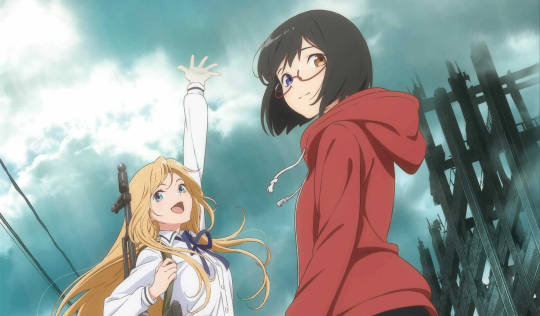
Quickest summary: 12 episodes. (Slowburn) yuri adventure-horror show about two college girls (Sorawo and Toriko) who explore a mysterious world they dub ‘Otherside’, populated by scary beings who take the form of various Japanese urban legends.
I basically want to say “yeah just read the novels” for this one, but if you’re not up for that, it’s not like the anime is bad or anything. It’s fine! The novels are just really good and the anime has very lackluster presentation, mostly due to lacking production values. The anime also has an issue of skipping/rearranging some things and not bothering to cover up the plotholes this causes (for instance, if you’re wondering why, in the anime, Toriko and Sorawo have a jarringly tone shifting FUN BEACH PARTY after having to leave some people to a rather horrifying fate, then they forget about those people for several episodes before finally following up on it- I assure you in the novels they DID very quickly discuss and follow up on these people and then had their fun beach party). The anime chose to rush some parts as well...then it ended on a not-super-exciting-note that left the whole thing feeling kind of mediocre.
The books are atmospheric horror adventure stories with a slowly developing romance as a big thread, and the show pretty much fails to capture the atmospheric horror due to having so little budget it relies on cringeworthy CGI and lacking visuals. There’s not much you can say about that. The show also suffers a bit from not including enough of Sorawo’s distinct, acerbic narrative voice (and the hilarious amount of times she’ll wax poetic on how hot Toriko is).
And finally, Toriko and Sorawo’s relationship is a slow-burn one, so this anime only covering the first two novels also means we don’t get to the explicit stuff that starts happening in volume three. If the anime leaves you feeling baited, I promise, this IS a genuine yuri/wlw romance, it just takes its time building up to it.
I think the stuff the anime did do very well with were the Akari episodes- the ninja cats episodes was almost as amusing as it was in the novel and the followup episode was extremely cute.
The Otherside Picnic novels are a quirky horror-romance-adventure blend I whole heartedly recommend. The books have a lot of appeal, including that they touch on the effects of trauma and abuse and the journey of healing in a subtle and moving way.
But, if you’re absolutely not up for reading the novels (or the manga, when it finally comes out), then I say definitely watch the anime- despite it’s limitations, it’s a fun time overall and the chemistry of the leads comes through. It’s such a rarity to have an enjoyable fantasy/sci-fi yuri anime about adult women out there. I’m sad it couldn’t get made with a better budget/direction, but I’m glad it was made at all. But if you come out of it feeling something is missing, I promise the source material is solid, great stuff that will leave you much more satisfied.
So I’m a Spider, So What?
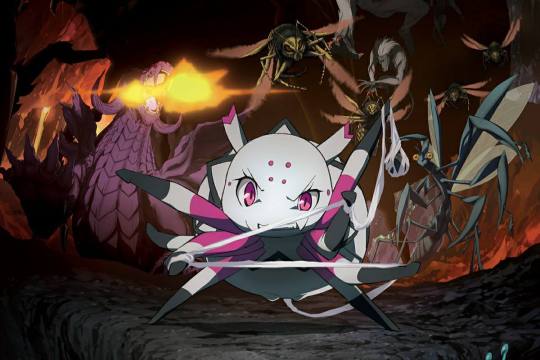
Quickest summary: 24 episodes. After a mysterious event that kills her entire class, a high school girl is reincarnated as a spider monster in a video-game-like dungeon and has to fight other monsters to level up and survive...meanwhile, the rest of her class has also reincarnated but are mostly living as humans elsewhere.
My quick take is the spider girl is very charming and Aoi Yuki’s frenetic performance carries the show. It’s when we get deep into isekai bullshit and get dragged down by production issues that things gets a little dicey. The show does some interesting things with the video-game-like world premise (for instance, there’s an entire cult worshipping the “you’ve leveled up your stats”! voice everyone gets in their heads as a god, which is incredible, I love that! There’s also hints that some of the characters are clinging desperately to the roles they had in their old lives in detriment of their new ones, which is interesting and a premise I actually see rarely explored in isekai! Unfortunately said characters are so painfully bland I can’t really care about that dilemma). But despite those interesting ideas, we spend a good chunk of the narrative with Spider-girl’s classmates, who are all such bland modern isekai archetypes that it makes it hard to care about them and the time we have with them generally a slog. Even spider-girl’s side of the story gets repetitive and predictable in some ways after a while. There’s like...way too much stats stuff going on here. The story also flips between two timelines that are fifteen years apart, which is an interesting conceit, but also means the entire season ends on a confrontation we never get to see resolved (AND ACCORDING TO THE ANN FORUMS, IN THE NOVELS YOU DON’T GET TO SEE IT FOLLOWED UP ON FOR SIX MORE VOLUMES OR SOMETHING??? WOW).
But probably the biggest issue that drags the whole thing down is the production values (and visual direction) running into huge trouble. The CGI was always a little shaky, but it takes a horrible nosedive in the back half, and the fights (and even some basic conversations!) become painful to follow or downright comically terrible looking. There’s some interesting kernels of fun ideas in this story, and a charming narrator in spider-girl, but the overall show just left me feeling empty. And considering I couldn’t get through the first novel since it cared WAY too much about listing out stat changes for my taste (I COULD JUST PLAY A VIDEO GAME YOU KNOW) (that part’s easier for me to take anime from when I can just zone out for a few seconds and watch the fights at least), I guess that’ll be it for me and this story!
Heaven’s Design Team
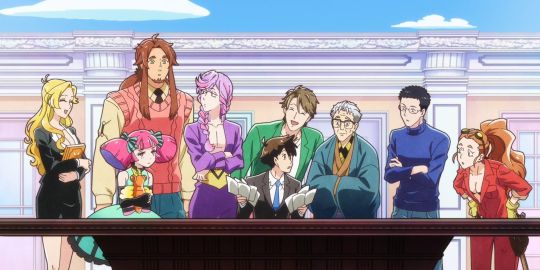
Quickest Summary: 13 episodes. This comedy edutainment show runs on the premise that God got tired of creating animals so he outsourced it to a design team of angels. It follows the quirky cast as they struggle to create animals that suit the clients bizarre specifications while still being functional.
This ended up being my favorite of the season (After Wonder Egg began to spoil, anyway). It’s just very cute, genuinely relaxing and funny, wholesome and educational. It has a really loveable cast- they weren’t super deep but their quirks made this really fun to interact. We’ve got a little girl obsessed with poison and gross things, a burly guy who wants to make cute animals. a fiery mechanic lady...they’re a good mix. And, notably, a positive portrayal of a transgender woman! Venus is a lovable character and probably my favorite in the show (cemented when she went through tremendous effort to drag a couch out of the closet just so she could collapse dramatically on it and lament her boss’s demands- MOOD) and everyone on the show respects her, uses the proper pronouns, and she’s shown hanging out with the other ladies in the women’s bath. She’s just completely accepted without comment, which shouldn’t be a huge notable thing, but it unfortunately still is. I think this is the first time in show clearly aimed at young children I’ve seen an explicit trans woman casually a part of the cast and treated with complete acceptance and respect? The only issue to note is she is voiced by a cis man, so I hope if a dub ever comes out they get a trans woman on that. There’s a good article on anifem for more infromation!
The show was just really nice and comforting watch. The humor of this show deals with weird, gross and surprising animal facts presented in a quirky way- I LOVE animals and how weird they are so that was great for me. There’s also a lot of shade thrown at how God is a Troublesome Boss who is always making whimsical demands of his beleaguered design team, which is done well and something any freelancer can relate to. I also appreciated how it had our Loveable Edgy Emo Demons from Hell making design requests for bizarre fantasy animals and coming up with weird explanations for those- they were some of the best gags.
Yeah, overall this was just a lovely, chill watch that I plan to put on whenever I’m feeling blue and want to revel in wholesome buds, gentle humor and bizarre animal facts. I really enjoyed it and have no reservations recommending it.
Jujutsu Kaisen (Part 2)

Quickest Summary: 24 eps, but only covering the second half with this review. After getting possessed by a demon, Junpei goes to a school to fight curses and meet other curse-fighting kids and do shonen stuff.
oh wait I forgot I finished this in winter! It was fine, a fun second half with a lot of pretty fights and good animation. The pacing on this show is still super weird, I can’t believe it took us 23 episodes to see what was ostensibly the main trio actually work together. BUT HEY, NOBARA FINALLY GOT TO BE REALLY COOL AND SCARY AND AWESOME AND WIN A BIG FIGHT (see the above pic). It was literally the last episode, but I loved seeing her be an unhinged terrifying murdergirl kicking ass and that she’s has a different (ie less guilt-ridden) philosophy/approach to killing than Junpei and discussed it with him was a thoughtful touch that developed her character and their dyanmic.
The other girls also got a good showing in the tournament arc (sans Miwa). It’s a little weird that the pairings ended up being divided by gender so ALL the girls conveniently fought each other and ALL the boys conveniently fought each other but, hey, the episode where the girls fought WAS really epic and Maki and her sister’s backstory and relationship developed nicely and was pretty interesting, and Maki did at least get to help fight the nature demon. I like Maki! It’s pretty decent treatment as far as battle shonen goes, none of the girls are ever oversexualized or harrassed and they all feel like characters for the most part. That’s such a low bar, but so few battle shonen clear it.
As far as the actual plot, still not anything too interesting to me, but the show makes for good eye candy and is a fun action extravaganza and sometimes that’s enough!
#otherside picnic#urasekai picnic#so i'm a spider so what#kumo desu ga nani ka#heaven's design team#winter 2021 anime#anime overview#reviews#my reviews#long post#jujutsu kaisen
60 notes
·
View notes
Note
More egg sorawo pretty please
🥺🥺🥺
ill work on getting the comics out but it’ll take a while cause i’m never satisfied with how they look so in the meantime have some old stuff when we just started dreaming her up


#i think about congrats on the homemade lupron girl all the time#rose u will always be famous 2 me#also in case anyone was wondering the diff btwn how i draw egg vs non egg sorawo#is they are the same but egg sorawo looks a little more haunted if possible#asks#egg sorawo
52 notes
·
View notes
Text
Miyazawa wrote in a fun little easter egg about Toriko's apartment into the new UraPi volume!
UraPi vol 8 spoilers below the break

If you follow the directions Sorawo gave you can actually find Toriko's apartment in Google Maps! The specificity of the directions invites the reader to imitate Sorawo's behavior in the early series to track down the site of the "true ghost story" that Sorawo is experiencing.
We know from both File 4 and File 26 that Toriko lives in room 404, so we know her apartment complex has at least four floors. It turns out, there's only one building in this area that fits the bill.
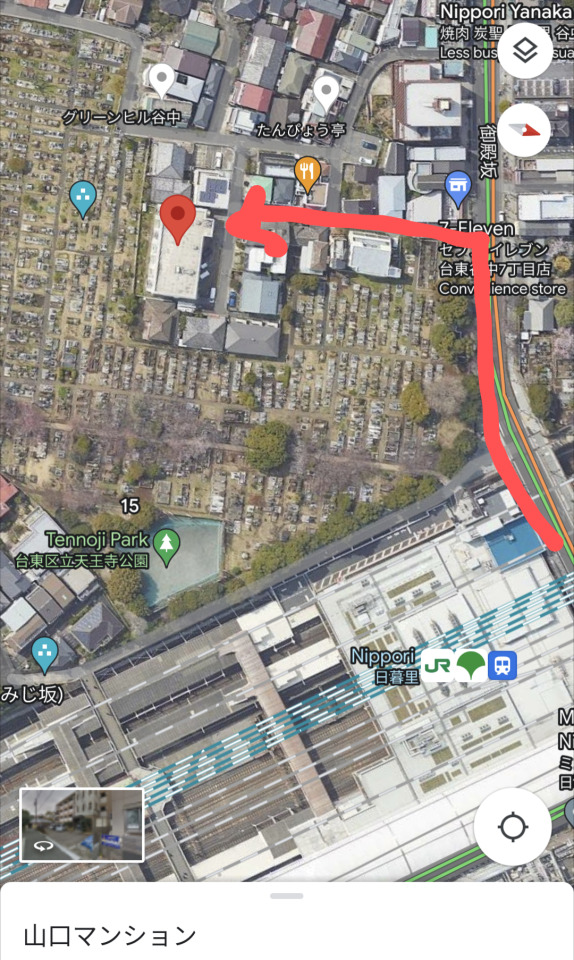
Okay, so now for the easter egg: check out the name of the apartment complex: 山口マンション (Yamaguchi Mansion). Yamaguchi translates to "Mountain Gate".
In vol 7, Satsuki described being brought over to the Otherside using a mountain as an analogy.
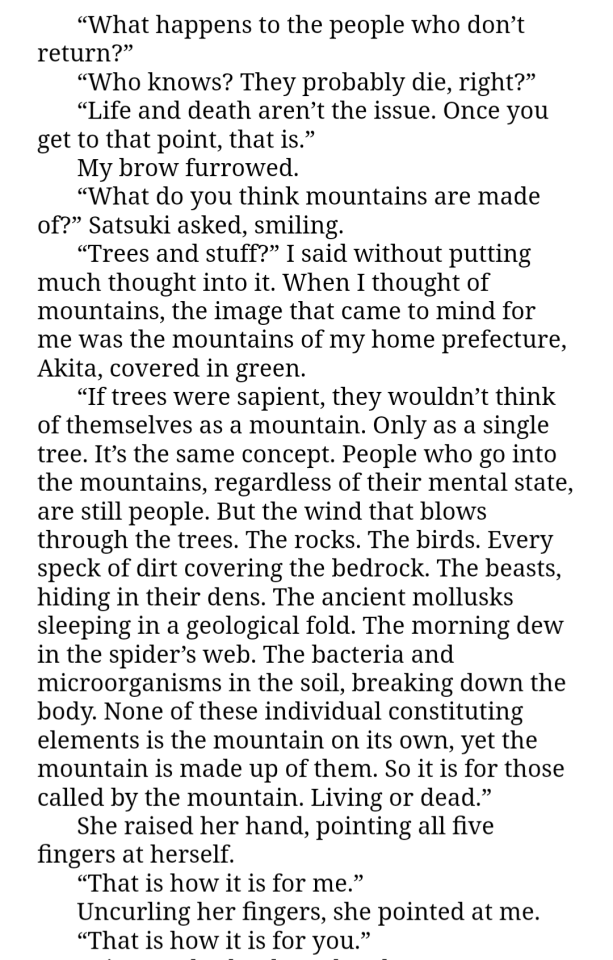
The "mountain gate" connection ties back to Sorawo's previous experience at Toriko's apartment back in File 4, where she opened the door to the apartment and encountered an ultrablue void.
I'm not sure at which point Miyazawa actually started planning this, but it's a really neat thing to add to the story. He's actively rewarding readers for engaging with every little bit of the story, and with just a few throwaway lines adds yet another layer of depth and symbolism to the story. Just astonishingly good writing in this series.
57 notes
·
View notes
Text
Otherside Picnic vol 8 spoilers below the break
It's always nice when a work retroactively adds new layers of complexity to previous parts of the story. A really neat, almost Easter egg-y, example of this is how the end of UraPi vol 8 makes a brief bit of descriptive text in File 15 ("Overnight in the Otherside") far more interesting.
After Sorawo and Toriko's intimate moment in the Otherside, they start trying to find a new label that's unique to them to move beyond the baggage they accumulated with "accomplice". Working off Toriko's suggestion of SoraTori, Sorawo hits on the idea of using a non-standard kanji for the nue (鵼, which can also be read as "strange bird"), taken from the first kanji in Sorawo's name (空魚) and Toriko's name (鳥子). Toriko says she knows about the yokai (a chimera with the face of a monkey, body of a tanuki, limbs of a tiger, and tail with the head of a snake), but Sorawo also mentions that the term can also be used to describe something with an uncertain shape. It's a really nice bit of wordplay that thematically plays in to Sorawo's resistance to having a relationship with a societally-defined shape.
Sorawo's solution was most obviously foreshadowed in the epigraph for File 23 ("Funeral of the Moon"), where the nue is mentioned as a harbinger of a soul summoning ceremony. It turns out, though, that Sorawo and Toriko's exploration of the Otherside in File 15 involves the nue as well.
The motif of the nue is clearest at the end of the file, when Toriko presents Sorawo with a knife with an epigram consisting of the first kanji of each of their names engraved side by side. The intended meaning is probably SoraTori (after all, she did try to name their first trail in the Otherside SoraTori as well), but can easily reinterpreted to read as nue with the benefit of hindsight.
However, the motif also occurs near the beginning of the file, when they have their first overnight stay in the Otherside. Sorawo and Toriko go up on a hill after dark to find a spotlight beam indicating the location of the gate they plan to trek to. Suddenly, they're weirded out by a pheasant's cry nearby, and scramble back to their camp as the darkness sets in. Rather than hang out at the campfire for a bit, the two run for their tent as Sorawo mentions the night darkness growing "terrifyingly deep". This comment sticks out, because at other points when Sorawo is in the Otherside at night, she makes no special mention of how dark it is.
Plumbing some of the deep lore around the nue suggests that Sorawo and Toriko probably encountered one on the hill without recognizing it. Over time, the cry of the nue came to be associated with the mournful cry of the scaly thrush. However, early versions of the nue myth identify the call as being associated with the green pheasant**. In the 14th century Heike Monogatari, Emperor Konoe is haunted by a nue, which is depicted as appearing from a thick black cloud that blots out the night, creating a darkness "so thick nothing could be seen".
By the end of vol 8, the nue, the relationship, and the Otherside have been explicitly linked to one another by the narrative. This early appearance of the nue motif might have symbolic meaning, perhaps a harbinger of the mounting pressure Toriko is putting on Sorawo for a romantic relationship. This sort of parallels some of Toriko's behavior in the tent that evening - getting pouty when Sorawo doesn't want to treat it as a camping date, wanting to link their sleeping bags together.
It's little details like this that make UraPi so interesting to me. It's tapping into one of the fascinating things about ghost stories - the wealth of detail that slowly created a series of coincidences that may or may not mean anything. Sorawo notes the following during the T-san saga: "When you dig through true ghost stories, there's no shortage of unbelievable synchronicity. Coincidences that seems to make no sense happen, and then end without ever making any sense. Things that are pure chance if you ignore them, but seem like ominous signs that you can read anything into once you let them bother you..."
Miyazawa is a ghost story nerd, and it's incredible how well he repurposes the framework of ghost stories to tell the story of a romance. Although he has said in interviews that he doesn't plan too far ahead and instead relies on sprinkling plot hooks into the story for himself, ttrpg-style, it really speaks to his mastery of the craft to do what he has with Otherside Picnic.
** The veiled connection to the pheasant also seems relevant to Kasumi's word salad in File 25. Although her first bit is translated as "Jack the Pisser", the original text is "Jack the Pheasant Hunter", 'pheasant hunting' being a Japanese euphemism for taking a leak.
32 notes
·
View notes